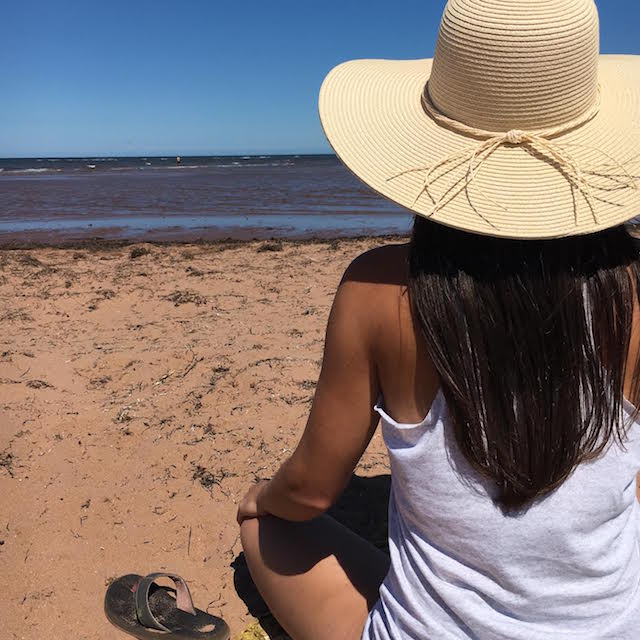My first meditation teacher used an analogy that instantly and forever impacted my understanding as a human being.
I have remembered and forgotten it a million times since then—such is the work of a spiritual being in a material world. His lesson outlined that all things come and go, like clouds through the sky, and our work is to sit as calmly as possible and bravely weather the storm.
Just before my 21st birthday, I sat for my first 10-day Vipassana retreat in Thailand. I had been traveling for months through Southeast Asia learning an incredible amount about Buddhism and various aspects of Eastern philosophy, forever changing the way I saw the world.
I was lucky enough to meet an inspiring Irish lady with whom I shared a last name. My Irish friend had just finished her first mediation retreat, 10 days of silent insight mediation, and she encouraged me to experience it for myself. I had no idea how much this experience would alter the course of my life.
Since these were the days before places like this would be searchable on the internet, I had to trust the information my travel companion was sharing with me, bus my way to the nearest town and hop a rickshaw completely filled with burlap sacks of mangos to reach my destination.
I arrived unscathed to the forest temple where the retreat was held. To this day I believe they offer a retreat at the beginning of every month. The months alternate between retreats for Thai people and ones for foreigners, which are luckily offered in English.
This was my first time doing anything like this; it was all completely new to me and a pretty amazing way to learn the basic underpinnings of the dharma.
While on retreat we followed a strict daily schedule. We rose at 4 a.m. every morning and spent our days in various forms of meditation practice—sitting, standing and walking. We had chores and dharma talks (teachings of the Buddha), chanting, loving-kindness meditations and a small amount of free time each day to do with as we pleased.
We ate twice daily, at breakfast and lunch and had tea in the afternoon, but no evening meal. Each evening we would practice a walking meditation together around candlelit ponds and sit for a last time as a group before shuffling off to bed. Lights out was set for 10 p.m. each night, and I cannot speak for anyone else, but I was more than happy to lay my head down by then and rest.
I know a schedule like this sounds crazy and even unpleasant to many of us. Particularly if it was something we would have to consider doing on a limited amount of holiday time, but there is great purpose to the way a 10-day retreat is structured, giving the practitioners just enough time to dig in to the layers of the subconscious and crack through some of our own deeply imprinted perceptions.
Everything at my retreat was gender segregated, from the dining room to our open air mediation hall, and, of course, the dorm areas. Each participant was assigned their own room complete with a concrete bed (which wasn’t nearly as bad as I imagined it would be) and a wooden pillow (which I’m not sure anyone actually used). We also had male and female specific ponds for walking mediation at night, and the amazing perk of natural hot springs to enjoy in our free time—which had been cleverly separated by encouraging the growth of trees and vines through the centre of the pools. These hot springs were my saving grace on some of the days I felt most personally challenged.
The first evening before we officially took our vow of silence for the following 10 days we had an orientation where we were given the schedule, expectations, and overall intentions of our time there. We were asked to be moderate with note taking during the retreat, to only record what was necessary for us to revisit later and to avoid journalling at all costs. We were instructed to not become wrapped up in the ebb and flow of the thoughts and feelings that would inevitably arise.
I didn’t know it at the time, but this was an incredible way to digest the concept of impermanence.
The first few days of the retreat felt like a balancing act for the mind. We would sit for hours of lectures that outlined the foundational teachings of the dharma, huge concepts when they are new to a Western mind, and then we would sit silently for hours, asked to move as little as possible, focusing on the rise and fall of our breath, being with whatever came up and trying to redirect the focus back to the breath.
If you have never experienced a long period of meditation before, taking on something like this can feel like you are literally jumping into the middle of the ocean, unsure how long it might take you to swim to shore.
During the course of 10 days I fell apart and put myself back together, silently, dozens and dozens of times. There were moments of ease and some of pain. Extreme moments of discomfort and many of boredom. There were moments when I felt like I lost myself into everything around me and everything in my experience was peaceful, at ease and sublime. However, there were other moments where it felt as though all I could do was dream of the future, toil in the past or sit and ponder what the stories of all my meditation companions were.
It is a fascinating experience to be locked into daily co-existence with people that you do not know and you are not able to communicate with in anyway. I am a busy brained person and there were many moments I could not help but move my attention through my environment with full hearted wonder of who the people who surrounded me were, where they all came from and what they were looking for?
One morning we gathered in the meditation hall after breakfast and settled into what was beginning to become a familiar silence. I began wrestling with the turbulence of my monkey mind and worked to concentrate my attention upon my breath.
And then the magical words came from the Abbot who spent the most time with us, the analogy I hold the most dear and will spend my life trying to honour.
He said that our thoughts and feelings come and go like clouds through a blue sky. The sky is the true self and the clouds are merely our thoughts and emotions, the impermanent and ever moving layers of the thinking mind.
Bingo! Have you ever had something explained to you that you instantly felt like you were remembering it rather than learning it? That’s how this lesson felt to me.
As my wise teacher explained, thoughts and feelings cannot be categorized as good or bad, they simply are. They are not permanent and they are not who we are.
Certain thoughts and feeling are intense. They are dark and heavy like thunder clouds and much more difficult to let drift by and to separate ourselves from, but remembering we are not our thoughts and feelings can be incredibly freeing.
The reason they asked us not to journal during our time at the forest temple was not because they didn’t want us to remember all the moments of our experience. It was an exercise to show that our experiences can often be quite swayed by whatever it is we are thinking and feeling in a moment. As human beings we tend to be attached quite deeply to our thoughts and feelings with various levels of craving and aversion. I want this…I don’t want that. When we begin to separate ourselves from this, when we give the clouds time to pass and come back to rest in the steadiness of our true nature, the blue sky, we are likely to experience a greater and more sustained equanimity.
These teachings are simple and super complex all at once. The struggle for most of us is that we can digest many of these concepts on an intellectual level, understanding the essence of the teachings and sometimes even having the ability to regurgitate and recite them, but putting the teachings into practice day after day in our real life is the only way we can truly appreciate the vastness of our own blue sky. We have to trust ourselves to weather our own storms and let the thunderclouds pass.
The gifts of meditation are incredible and you don’t have to commit yourself to 10 days of silence to start. What many mediation teachers suggest is to start small, even three to five minutes at a time. This can make a profound difference when most of us are living at a such a pedal to the metal pace.
There are scientific studies that show any amount of time we can commit to expansive, mindful breath is of benefit, giving us the chance to still the noise of our thinking mind and perhaps observe with some clarity how many layers of thought and emotion we are generally processing.
In the years since my first retreat I have lost and found my meditation practice dozens of times. I have also spent years getting to know my true self through the practices of yoga. It all serves me. Now as the owner of a small yoga studio with the good fortune to spend my days sharing various aspects of these practices with other people I feel a deeper calling to get real about my spiritual work.
Something recently shifted and I feel like I am now in a new phase of my spiritual exploration. My mind is constantly floating between a moment to moment contemplation of some of these teachings and then surrendering into beautiful stillness where I can come home to rest into my true self. Truly putting all of this to work together and genuinely walking my talk can, of course, only really be supported by actually placing my seat onto the meditation cushion day after day.
To this day it is uncertain what kind of clouds I will encounter through my journey, but I am committed to the path that is laid before me and will work to spend my days honouring this idea of weathering the storm.
I invite you to spend some time with yourself in silence as well, to get acquainted with all the layers of you, all the churning thoughts, all the feelings, as well as the strong foundation of your true nature beneath it all.
Meditation can be quite similar to laying on the grass on a summer day and literally watching the clouds in the sky, and if you’re looking to jump into the deep end I can recommend a great place to go spend 10 days in life changing silence.
![]()
~
Author: Chelsea McCormack
Image: Author’s Own, photo by Wes Eisses
Editor: Travis May







Read 44 comments and reply